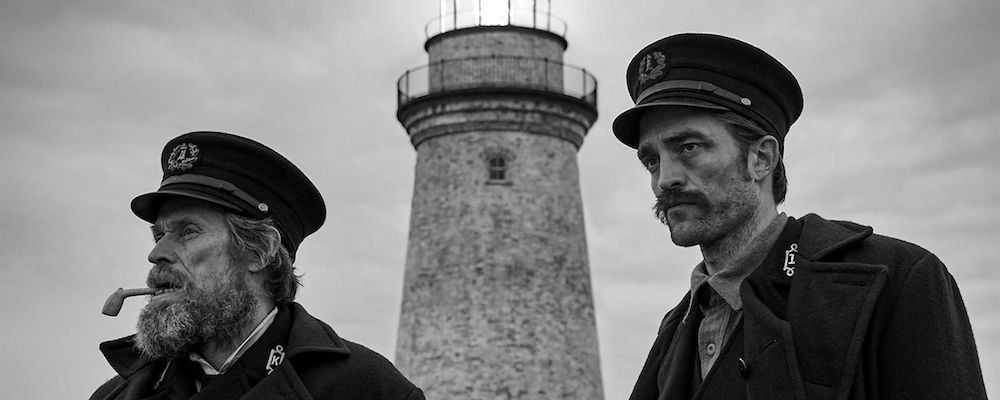Willem Dafoe and Robert Pattinson Descend Into the Utter Madness of ‘The Lighthouse’
Alci Rengifo
“The Lighthouse” is one of those rare films that becomes nearly impossible to categorize. Phantasmagoria and psychological drama, visually hypnotic yet unnervingly gritty, it has all of these elements swirling in a feverish mixture. At its core it captures unflinchingly a sense of being isolated and trapped. To describe the plot almost defies the point. Director Robert Eggers, who in 2016 announced himself as a bold new talent with “The Witch,” pulls the audience into a psychological landscape that feels from another era.
It’s the 1890s and time becomes a haze as from a misty ocean emerges a ship headed for a distant lighthouse. Two men will live on the small island from which the massive tower of light rises, Thomas Wake (Willem Dafoe) and Ephraim Winslow (Robert Pattinson). The area is continuously lashed by wind and bestial waves. Thomas is the one in charge while Winslow took the gig hoping to get some economic stability. Their days are spent amid the glow of lamps and boredom. Winslow is tasked with chores which include cleaning, repairs and even more unsavory tasks like disposal of their chamber pots. But Winslow begins to sense a malevolent force at play. In the evenings Thomas appears to make his way up to the lighthouse, staring into its glow. Strange visions and dreams torment the younger man to the point where the line between reality and fantasy blur.
There is a folky power to Eggers’s work that again manifests itself in “The Lighthouse.” The subhead of “The Witch” was “A New England Folktale,” and he could very well have added a similar line to the title of this movie. The setting is as simple as it can get, two men alone on an island. In the way folk stories passed down through the years can start from the smallest premise, Eggers turns the surroundings of these two men into an intense battleground of hallucinations and boiling rages. There is a timelessness to the material because it never resorts to acting like a conventional period piece. Dafoe in particular speaks with the lingo of a classic seaman out of myth, evoking Neptune and sea monsters in his anecdotes and insults. He smokes a pipe and treats Winslow with a condescending tone. His face looks taken out of the pages of Melville’s “Moby Dick.” Robert Pattinson is completely transformed in his role, taking on a gruff exterior and turning it slowly into a portrait of a man going deranged.
However to describe “The Lighthouse” is to report on tones and moods, atmosphere and imagery. Similar to 1920s German Expressionist cinema, this is a film whose canvas works as a visual experience. Eggers and cinematographer Jarin Blaschke, who achieved Goya-like textures in “The Witch,” frame the movie in a classic 1:19 ratio with a grainy black and white that makes it all look like some lost film from the early sound era. Like the films of Guy Maddin, “The Lighthouse” feels like its own vintage reality. Storm clouds, restless waves and lightning have an eerie, unreal quality. The editing takes on the rhythm of a nightmare. One moment Winslow and Thomas are eating a sloppy dinner then we see Thomas naked before the lighthouse’s glow as if communing with some other power. Winslow does his chores and faces off with an enraged seagull, at one point he will mercilessly kill another such bird. He wanders towards the shore and finds a mermaid (Valeriia Karaman) washed upon the rocks. Is it a vision or reality? When he embraces her is it simply his desires getting out of control? There is a boldness to how Eggers films these moments with the very tonality of the subconscious producing reels of images and feelings. The music by Mark Korven, who also gave the “The Witch” a Satanic undercurrent of sound, here propels the images forward with a droning that evokes a ship’s distant horn.
While atmosphere dominates “The Lighthouse,” there is still a narrative that builds to a visceral climax. As Winslow suspects Thomas of the unexplainable strangeness on the island a confrontation takes shape. When a storm leaves them stranded without supplies the provisions are endless bottles of alcohol, which they consume mercilessly. Soon drunken conversations form, secrets are revealed and Winslow feels he has to break from this man’s grasp as the visions continue and Thomas rambles in semi-mystical language. It’s the kind of movie you truly need to see to believe. The final shot is both morbid and unforgettable, worthy of a film by Fernando Arrabal. If you recognize that name, you will be even more in tune with what Eggers is attempting with this movie. It’s a take on the classic theme of men out at sea, filtered through the madhouse of surrealism. There’s a great wildness to moments where the two men drink and dance around singing sea shanties. Maybe this is what life was like in those days when such jobs had to be done with little contact with the outside world.
“The Lighthouse” is challenging but not dense, visually immersive in a tricky way we welcome because few movies these days are so creative. Eggers is out to make art while basking in the simple joys of making a movie. This is the kind of film that may seem hard to get at first, but it can’t be shaken away.
“The Lighthouse” opens Oct. 18 in select cities and expands Oct. 25.

